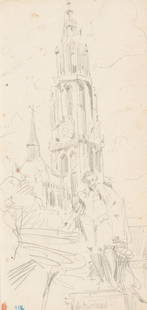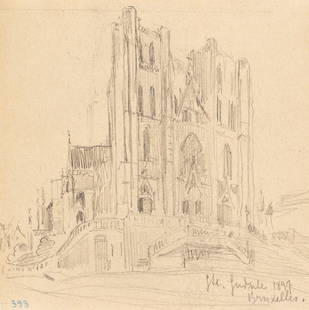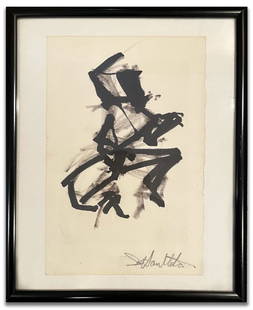
JUAN BARJOLA (Miguel Sesmero Tower, Badajoz, 1919 –
Similar Sale History
View More Items in DrawingsRelated Drawings
More Items in Drawings
View MoreRecommended Art
View More







Item Details
Description
JUAN BARJOLA (Torre de Miguel Sesmero, Badajoz, 1919 - Madrid, 2004).
"Bullfighting", 1967-1970.
Oil on panel.
Work registered in the artist's private archive. NO. 04/05/18.
Attached certificate issued by the artist's son, Don José Antonio Gadea.
Signed in the lower right corner.
Measurements: 23.5 x 32.5 cm; 48.5 x 58 cm (frame).
Barjola brings together in this bullfighting painting the figure of the bullfighter, the bull and the horse. Three elements that merge together and provide a unifying vision that allows us to capture the atmosphere of a bullfight, the tension and the drama of the act of bullfighting made into a painting.
Belonging to the current of representational expressionism, Juan Barjola is one of the most outstanding Spanish painters of the second half of the 20th century. Even as a child he showed a love of drawing, which led his parents to guide him along the path of art. At the age of fifteen Barjola arrived in Badajoz to begin his training, and entered the city's School of Arts and Crafts. Fully committed to his incipient career, in 1943 he moved to Madrid, where he first studied at the School of Arts and Crafts in Calle La Palma and later at the San Fernando School of Fine Arts. At the same time, he furthered his training at the Prado Museum, where he copied Velázquez and interpreted Goya, Brueghel, El Greco and Bosch. During this period, which ended in 1950, Barjola produced a series of academic works of a naturalistic style, with themes taken from family life, suburban characters and other genre scenes. Towards 1950 he began a new post-cubist phase, the prevailing trend in Madrid at the time due to the influence that Daniel Vázquez DÃaz exerted on an entire generation. During these years Barjola would develop faceted images, with a flat treatment and cold, bluish colours. At the same time, he began to develop a new, more constructive stage, marked by earthy colours. In 1957 Barjola made his solo debut at the Abril gallery in Madrid, and that same year he held two more solo exhibitions in Brussels, at the Theatre and Vallvora galleries. He then embarked on a brilliant exhibition career that took his work to Europe, Japan, the United States and Latin America. Around 1958 he began a short but intense period in which he experimented with an abstract language in which the pictorial material took centre stage. His work was now marked by thick, sumptuous impastos of sordid, dark colouring, which made up abstract, organic still lifes. This was the heyday of the material abstraction led by Tà pies from Barcelona. A year later, without the thick impasto disappearing, the organic stains began to be resolved into human embryos, the result being a return to figuration in line with the international trend initiated by Francis Bacon. Barjola thus became the main Spanish representative of the New Figuration. At the same time his work became increasingly recognised; in 1960 he received a grant from the Juan March Foundation which enabled him to travel to Paris and Belgium, and in 1963 he was awarded the Eugenio D'Ors Medal by the critics. That same year he exhibited at the Dirección General de Bellas Artes, and shortly afterwards he won the National Drawing Prize at the National Exhibition (1968). Towards 1964 his work underwent a new evolution, marked by the paintings of Velázquez, Goya and El Greco. This marked the beginning of the painter's Golden Age, with paintings transformed by the appearance of the human figure, three-dimensional space, natural light and the open air. The thick impasto disappeared and his language became more fluid, while his colours became brighter and more luminous. At the same time, Barjola created a series of works of brutal expressionism and great visual power, linked to the themes of violence and war.
"Bullfighting", 1967-1970.
Oil on panel.
Work registered in the artist's private archive. NO. 04/05/18.
Attached certificate issued by the artist's son, Don José Antonio Gadea.
Signed in the lower right corner.
Measurements: 23.5 x 32.5 cm; 48.5 x 58 cm (frame).
Barjola brings together in this bullfighting painting the figure of the bullfighter, the bull and the horse. Three elements that merge together and provide a unifying vision that allows us to capture the atmosphere of a bullfight, the tension and the drama of the act of bullfighting made into a painting.
Belonging to the current of representational expressionism, Juan Barjola is one of the most outstanding Spanish painters of the second half of the 20th century. Even as a child he showed a love of drawing, which led his parents to guide him along the path of art. At the age of fifteen Barjola arrived in Badajoz to begin his training, and entered the city's School of Arts and Crafts. Fully committed to his incipient career, in 1943 he moved to Madrid, where he first studied at the School of Arts and Crafts in Calle La Palma and later at the San Fernando School of Fine Arts. At the same time, he furthered his training at the Prado Museum, where he copied Velázquez and interpreted Goya, Brueghel, El Greco and Bosch. During this period, which ended in 1950, Barjola produced a series of academic works of a naturalistic style, with themes taken from family life, suburban characters and other genre scenes. Towards 1950 he began a new post-cubist phase, the prevailing trend in Madrid at the time due to the influence that Daniel Vázquez DÃaz exerted on an entire generation. During these years Barjola would develop faceted images, with a flat treatment and cold, bluish colours. At the same time, he began to develop a new, more constructive stage, marked by earthy colours. In 1957 Barjola made his solo debut at the Abril gallery in Madrid, and that same year he held two more solo exhibitions in Brussels, at the Theatre and Vallvora galleries. He then embarked on a brilliant exhibition career that took his work to Europe, Japan, the United States and Latin America. Around 1958 he began a short but intense period in which he experimented with an abstract language in which the pictorial material took centre stage. His work was now marked by thick, sumptuous impastos of sordid, dark colouring, which made up abstract, organic still lifes. This was the heyday of the material abstraction led by Tà pies from Barcelona. A year later, without the thick impasto disappearing, the organic stains began to be resolved into human embryos, the result being a return to figuration in line with the international trend initiated by Francis Bacon. Barjola thus became the main Spanish representative of the New Figuration. At the same time his work became increasingly recognised; in 1960 he received a grant from the Juan March Foundation which enabled him to travel to Paris and Belgium, and in 1963 he was awarded the Eugenio D'Ors Medal by the critics. That same year he exhibited at the Dirección General de Bellas Artes, and shortly afterwards he won the National Drawing Prize at the National Exhibition (1968). Towards 1964 his work underwent a new evolution, marked by the paintings of Velázquez, Goya and El Greco. This marked the beginning of the painter's Golden Age, with paintings transformed by the appearance of the human figure, three-dimensional space, natural light and the open air. The thick impasto disappeared and his language became more fluid, while his colours became brighter and more luminous. At the same time, Barjola created a series of works of brutal expressionism and great visual power, linked to the themes of violence and war.
Buyer's Premium
- 23%
JUAN BARJOLA (Miguel Sesmero Tower, Badajoz, 1919 –
Estimate €10,000 - €12,000
1 bidder is watching this item.
Get approved to bid.
Shipping & Pickup Options
Item located in Barcelona, Barcelona, esOffers In-House Shipping
Payment

Related Searches
TOP






















![Juan Luna "Sketch of a European Lady" pen and ink: JUAN LUNA Y NOVICIO (Filipino 1857-1899) "Sketch of a European Lady" Pen and ink on paper. 7 3/4 x 5 inches. Signed l/r. [CONDITION: In overall good condition. Slight time staining to the sheet.]](https://p1.liveauctioneers.com/1098/96956/49448235_1_x.jpg?height=310&quality=70&version=1480033474)


























![Unknown (19th), City view with palm trees. North Africa, 1850, Pencil: Unknown (19th century): City view with palm trees and architectural elements North Africa, 1850, Pencil Technique: Pencil on Paper Inscription: Middle left inscribed: "Djima St Kibera [?]". Middle lef](https://p1.liveauctioneers.com/7191/328344/176914968_1_x.jpg?height=310&quality=70&version=1714635950)
































